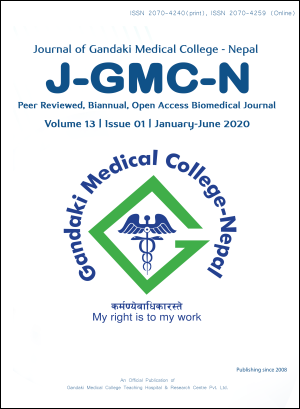Prevalence of Extended Spectrum Beta Lactamase Producing and Carbapenems Resistance Isolates from Hands of Health Care Workers in a Health Care Setting of Nepal
DOI:
https://doi.org/10.3126/jgmcn.v13i1.28461Keywords:
Carbapenems-resistance, Extended Spectrum Beta Lactamase Producers, Health Care WorkersAbstract
Background: Hands of healthcare workers (HCWs) could be colonized by potential drug resistant bacteria like Extended Spectrum Beta Lactamase producers (ESBLs) and Carbapenems-resistant (CR) isolates and could become vectors of nosocomial pathogens in healthcare facilities that are associated with an increase of morbidity, mortality and healthcare costs. This study aimed to investigate the prevalence of ESBLs and CR isolates from hands of HCWs with their antibiotic susceptibility pattern.
Materials and methods: This was a cross-sectional study that included a total of 150 hand swabs collected from March, 2018 to September, 2018 in Gandaki Medical College and Teaching Hospital. Isolation, identification and antimicrobial susceptibility tests were done using standard microbiological procedures.
Results: Among the total isolates of 219 obtained from growth positive samples 92/219(42.01%) were Gram negative bacteria (GNB) and the most common were Klebsiella spp 32(34.78%) followed by Escherichia coli 17(18.48%), Pseudomonas aeruginosa12 (13.04%), Acenetobacter spp 11(11.96%), Proteus spp 9(9.78%), Citrobacter spp 7(7.61%) and Enterobacter spp 4(4.35%). The prevalence of ESBLs, CR and ESBLs with Co-resistant to Carbapenems were 19.56%,14.13% and 9.78%, respectively. The most effective drugs for isolates were Nitrofurantoin followed by Amikacin, Tetracycline and Gentamycin. Distribution pattern of the ESBLs and CR isolates among doctors, nurses, laboratory technicians, helpers and basic science faculties were not significant (p>0.05).
Conclusions: This report revealed the emerging and moderately high prevalence of ESBLs, CR and ESBLs with Co-resistant to Carbapenems GNB with their antibiotic susceptibility patterns found on hands of HCWs in Nepal. Thus, this study could be helpful in developing proper guidelines on hand hygiene and implementation of infection control measures including contact precautions against the spread of infections by such pathogens in healthcare settings.
Downloads
Downloads
Published
How to Cite
Issue
Section
License
This license allows reusers to distribute, remix, adapt, and build upon the material in any medium or format for noncommercial purposes only, and only so long as attribution is given to the creator.




